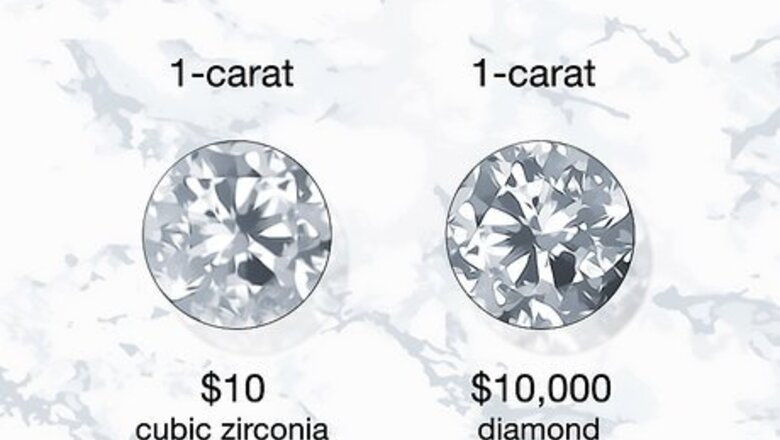
views
- Hold your piece up to the sunlight. If it shines with a rainbow of colors, it's likely cubic zirconia.
- Breathe onto your piece so it fogs up. If the fog disappears quickly, your piece is likely a diamond. If it takes 30 seconds or more to fade, the piece is probably cubic zirconia.
- If your piece gets cloudy or scratched over time, it's most likely cubic zirconia.
Easy Home Tests
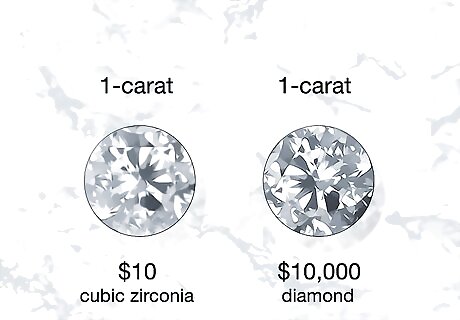
Identify cubic zirconia by a lower price. Since cubic zirconia is made in a lab, it is much cheaper to cut and produce. A 1-carat cubic zirconia piece can go for around $10, while the same carat diamond could sell for $10,000. A much lower price almost always indicates that a piece is a cubic zirconia and not a diamond. Colored diamonds are often much more expensive than colorless ones, while colored cubic zirconia will be around the same price as colorless cubic zirconia.
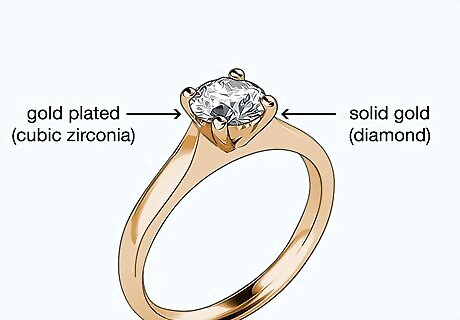
Check for cheap jewelry settings to spot cubic zirconia. Since cubic zirconia is cheaper than a diamond, it is usually set in jewelry that is slightly cheaper. If the settings of your jewelry are gold plated or gold-filled instead of solid gold, there is a good chance that it is cubic zirconia. Check the markings on the inside or back of your jewelry. If they say 10K, 14K, or 18K, they are solid gold and you most likely have a real diamond. If the jewelry says C.Z., it is cubic zirconia. Diamonds are sometimes set in jewelry that is not solid gold, so this cannot tell you definitively if your piece is a diamond or not.
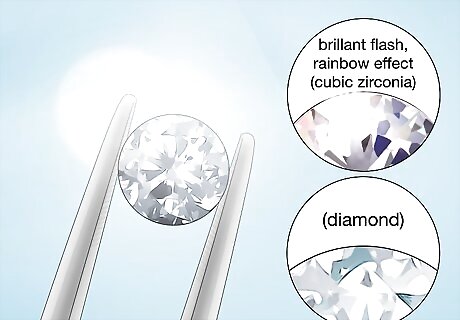
Put your piece in sunlight to see a brilliant flash that indicates cubic zirconia. Diamonds play with light well, but cubic zirconia creates even more of a rainbow effect when it is in the sun. Take your piece outside and see how it reacts to the light. If it shines a lot with many colors, it is probably cubic zirconia. Smaller pieces of cubic zirconia may not be as brilliant.
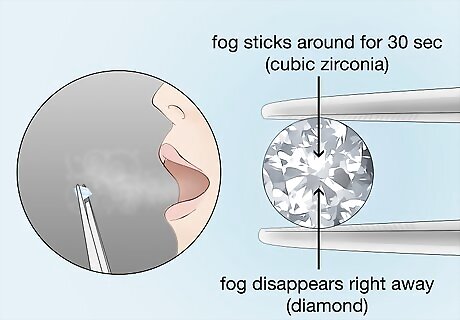
See if fog disappears quickly on your stone to indicate a diamond. Breathe hot air onto your piece to create fog. If the fog disappears right away, your piece is most likely a diamond, since diamonds have low thermal conductivity and can’t hold on to heat for very long. If the fog sticks around for 30 seconds or more, your piece is most likely cubic zirconia since it has a high thermal conductivity and can hold onto heat for a while. You can also use a diamond tester that measures thermal conductivity if you have one. Higher thermal conductivity usually indicates cubic zirconia.
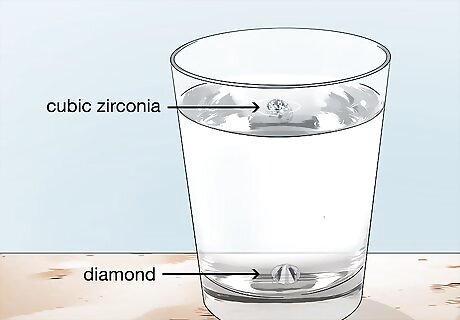
See if your piece sinks to identify a diamond. Fill up a glass about ¾ of the way full of room temperature water. Drop your loose stone into the glass. If the stone floats, it is most likely cubic zirconia. If it sinks, it is most likely a diamond, since diamonds are denser than water. Use tweezers to pick your stone out of the water after you are done with your test so that you don’t lose it. This test will not work if your stone is set in a piece of jewelry.
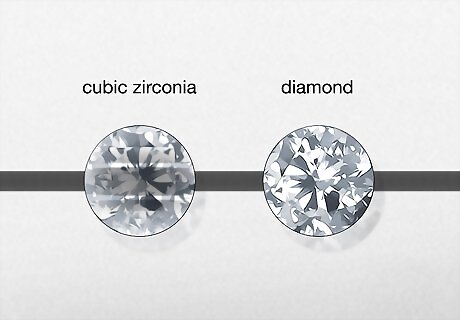
Test for opaqueness to identify a diamond. Draw a black line with a permanent marker on a piece of white paper. Set your piece over the line. If you can see through your piece to the line underneath, it is most likely cubic zirconia. If you can’t see the line, it is probably a real diamond. If your piece is already set in jewelry, you will not be able to do this test.
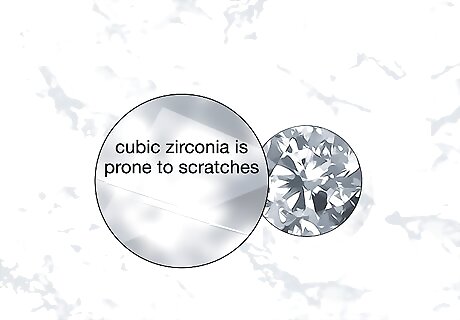
Watch out for scratches or chips over time that may indicate cubic zirconia. Diamonds are very durable and are not prone to scratches. If your piece is scratched or cloudy after a few years of use, it is most likely cubic zirconia. If it has any chips or gouges in it, it is also most likely cubic zirconia.Tip: If you do have a piece that is cubic zirconia, be more gentle with it than you would be with a diamond.
Using Jewelers’ Tools
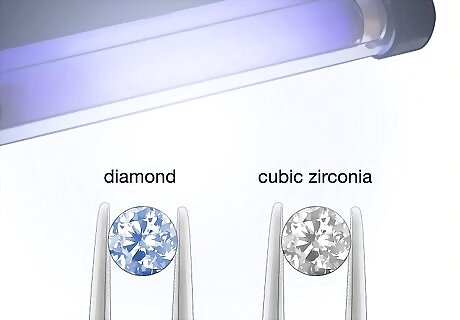
Place the stone under a UV light to see if it glows blue to find a diamond. Set your stone or jewelry piece under a UV light. If the piece glows blue, it is most likely a real diamond. If it does not glow at all, it could be cubic zirconia. Some diamonds do not glow under UV light, so this is not a definitive test. You can buy small UV lights at most hardware stores.
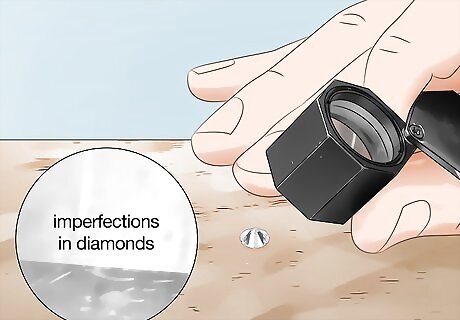
Look for a flawless piece to spot cubic zirconia. Cubic zirconia is created artificially in a lab, so the creators can control how many spots, lines, or imperfections it has. If the piece does have some flaws, it is most likely a diamond. Use a microscope or a magnifying glass to look at your piece up close.Tip: Although some diamonds look flawless from far away, they all have at least a few small imperfections.
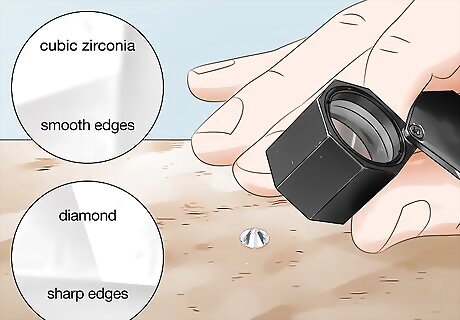
Examine the edges to see if they are smooth to indicate cubic zirconia. Use a jeweler’s loupe with 10x magnification to look at your piece. The flat, geometric surfaces, or facets, of your piece will be much rounder and smoother if it is cubic zirconia. Diamonds have sharp, hard facets. This will be especially prominent if your piece is older.
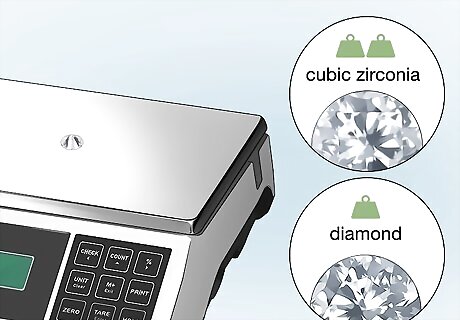
Weigh the jewelry to see if it is heavier than a diamond of the same size. Diamonds and cubic zirconia may look similar, but cubic zirconia weighs almost twice as much as a diamond of the same size and proportions. Use a small scale or hold 2 items of jewelry in your hand to compare the weights. Pieces of jewelry are harder to compare weights since they have metal that can make them feel heavier.














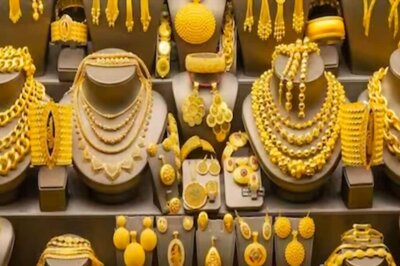

Comments
0 comment